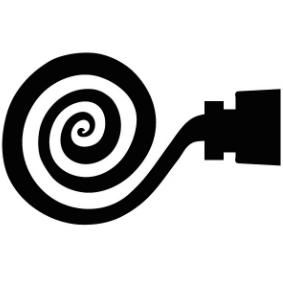The Supai Indian (1945)
Starts without opening credits (see notes below). Havasupai man (apa/ba) with a white cowboy-type hat leading a white horse (olu) that’s carrying a load of branches in baskets between Cottonwood trees (ahaaa?), Havasu Falls waterfall in the background; another man riding his now unburdened white horse, and leading another white one carrying goods, into and across a river (ahela) (Havasu Creek); various wide views of Havasu Canyon, Arizona (identified in the film by a former name Cataract Canyon) including various canyon walls like the rock face with two pillars (Wigleeva) a village, and green trees and vegetation on the canyon (chikumile) floor; the three horsemen riding across a narrower part of the creek; then repeat footage of the man riding his now unburdened white horse, and leading another white one carrying goods to the creek’s edge; a waterfall in the distance, large trees in the foreground; different shots of Havasu Falls; two men on horseback and a little white dog (had/ahat) running down a dirt road (inyaa) between trees and along a canyon wall; the same road farther down, now lined with groups of men on horseback and others on foot watching as they run past; closer view of the two young male riders and their horse, people wander past the camera; closer view of one rider blue shirt who smiles at the camera and take off his hat, his brown horse alongside; then close-up of his smiling face; close-up of a small boy (hemée) hanging onto a metal bar, smiling; close-up of an older woman (bathii/pakri) smiling at the camera; close-up of a younger woman using her finger to apply a circle of red ochre paint to her cheeks, and a close-up of her index finger dipping into the small dish with paint; a naked boy runs past and away from the camera through the creek water and splashes down into it letting the water move him down stream, little kids sit nearby; another boy in shorts jumps from the bank into the water; two boys practice lassoing a dried cactus they roll down an incline, two watch, one boy succeeds and they pull it back up; close up of a middle-aged man with a small boy on his back, both smile at the camera, then the camera pulls back to reveal the man is seated on a horse and the boy is standing while he hangs on, a rock face and dirt road behind; they then ride off away from the camera down the tree-lined road; the man now stands a Dutch door of the Supai Arizona Post Office, the (white) woman inside welcomes him in; the camera pans down a radio tower to a post office building below, rock face in the background; shots of the postmaster speaking into the receiver of a shortwave radio kit; the exterior of a schoolhouse, with trees in front and rock faces behind; children playing and around a large swing set, rock formations and schoolhouse beyond; closer view of the schoolhouse bell ringing; adults escort a small group of children into the front door of the one-room schoolhouse; alternating shots of a white teacher speaks to her small classroom full of student and leads them in song and of the students seated in their desks singing; wide shot of two men walking through the canyon in a grove of trees, and then focussing on one man in a corn field with tall stalks; he inspects his corn; close shots of a woman seated on the ground tosses corn kernels and small black pieces of coal in a flat cooking basket, a mano and metate sits nearby; another woman walks carrying a stick and a cone-shaped basket hangs from her forehead onto her back; now carrying the basket in her hand, she walks over to a tree and using the long stick she beats the branches; she then gathers up peaches from the ground into her basket; she walks over to an open area and drops her stick; closer views of her breaking the peaches in half, tossing the pit, and organizing them in a large blanket of them drying in the sun; wide shot of the basket with fresh peaches and the large plot of drying ones; Havasu Falls; wide shot of Havasu Canyon and village. End credits: “The End, Coronet Instructional Films.”
Full credit sequence clip here, courtesy of Periscope Film.“Coronet presents The Supai Indian, Copyright 1945, Coronet Instructional Films, A Division of Esquire Inc.” superimposed over a color illustration of a what looks like Havasu Falls waterfall; it continues “This picture was made through the courtesy of United States Department of Interior, Office of Indian Affairs, Supervision by Alfred Whiting, Museum of Northern Arizona.”




